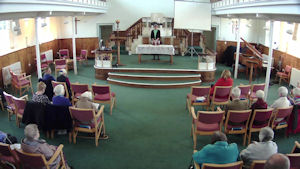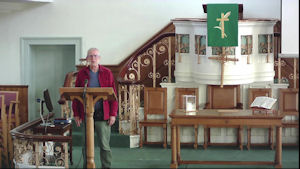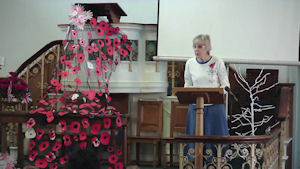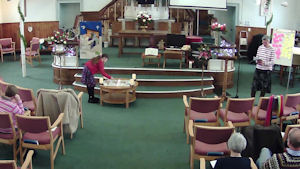
Sam Hallas' Website
During the Covid-19 pandemic, when the country was in so-called lockdown, the Church that Sheila and I attend wanted to continue to meet but to do so using modern technology. The simple answer, which was adopted by many churches, was to use an online conferencing application. Several were available - Microsoft Teams, Google Meet, Skype and Zoom.
The Church asked around to find out what other churches were using and the most popular software proved to be Zoom
Zoom proved easy to set up, working on mobile phones, tablets, laptop and desktop computers. It is also accessible by telephone for those without a suitable device. It allows participants to see each other or can switch automatically to the current speaker. Image and speech quality were good. The audience can be restricted to avoid intruders. Participants can interact with each other and the leader.
Zoom is not free if the meeting is to be longer than 40 minutes. However the price is reasonble and the paid-for version has features not available on the free version. Music quality is just about tolerable. Participants must be allowed into the session by a leader. There is a variable delay between vision and sound - the picture usually lags behind speech. Zoom has no mechanism for paying royalties on copyright material shown, which limits the choice of songs to those available on YouTube. Otherwise an expensive streaming licence would be needed. The content is ephemeral - it has to be watched as it happens. If the service is recorded it requires some effort to edit and upload. The finished quality is just about adequate.
Even during lockdown, services for funerals were permitted, albeit with limited attendance. Under such circumstances the ability to broadcast seemed attractinve to allow a larger, remote congregation. This hastened our thoughts about how to continue to provide remote viewing once regular services were resumed. The experience gained in using Zoom made clear that it was not ideal for broadcast of live in-person services. We therefore looked at the most popular broadcast application already used by churches, YouTube.
Youtube is free to use. It is easy to view on mobile phones, tablets, laptop, desktop computers and smart televisions. Content is retained after a service and can be viewed later at any time. Image, speech and music quality are excellent. Material can be pre-recorded for later viewing. YouTube has a comprehensive scheme for paying royalties on copyright material broadcast, meaning that a separate licence is not required. More flexible presentation is possible such as multiple camera angles, text overlays, visual effects such as greenscreen. Anyone can view without needing an invitation. Viewers cannot interrupt the service.
More complicated to broadcast - requires a computer or hardware streaming device. Interaction is not possible. Streaming from a mobile phone requires the YouTube account to have at least 1,000 subscribers.
The Church has a perfectly satisfactory public address system providing speech reinforcement. It was donated by members and has column speakers fed from a 16-channel mixing desk feeding a 30 Watt amplifier. We have a selection of microphones, both fixed and wireless. There was also an internet connection feeding a WiFi system in the rear of the building, now extended to the sanctuary.
In addition, for many years we have been using Songpro projection software which uses a laptop computer, projector and screen at the front to display hymn words, presentations, pictures and videos.
Our Church has a small team who regularly work the sound system and project the hymn words. We agreed that any system for broadcast should be simple to operate, self-explanatory, not needing any technical knowledge. It should also be "switch on and go", not requiring setting up at each service.
Like many churches, ours has limited financial resources so keeping the cost down for a broadcast system was another important requirement. Research into what some other churches were doing found some installations cost a staggering amount - a few thousand pounds - but, as a result, were capable of studio quality video. It seemed prudent to look carefully at our needs so as to keep expense to a minimum.
In order to broadcast video of services in addition to the existing hardware we would need some cameras and some streaming hardware to send the sound and pictures to the internet. The choice of equipment depends on the type of presentation chosen, tempered by the needs in the heading: simple and cheap.
The sort of presentation chosen dictates the equipment needed.
Simple: The simplest presentation would be the 'person in the back row' view of the service.This could be achieved very simply with a mobile phone or tablet. Alternatively a laptop with and external webcam would serve. However, any content shown on the screen in Church would be difficult to read. The picture above shows the effect.
Simple Plus: As for Simple but with the ability to switch to the screen output to display song words or slide/ video presentations. This would need a camera and some sort of computer such as a laptop.
Multi-angle: Adds the ability to switch between, say the simple long shot or a close up of the leader and the word/ slides/ video. This would need more than one camera, and a computer or a dedicated video switch with a hardware streaming device.
The Multi-angle option produces the most flexible and professional-looking result and so we opted to go for it but in as thrifty a way as possible.
As a Baptist Church our services are of much the same format as most non-conformist chapels. The action takes place at one end of the sanctuary or auditorium. Any parading in and out is limited to weddings, funerals and scout/ guide parades. Although we have a raised pulpit, it is seldom used. The minister leads the service from a lectern on the left-hand side of the dais, others may read bible passages or pray from another lectern on the right-hand side and communion is served from a central table.
What takes place in a service is typically as follows.
Therefore the scenarios we need to present are:




Part Three: Streaming (Hardware & software)